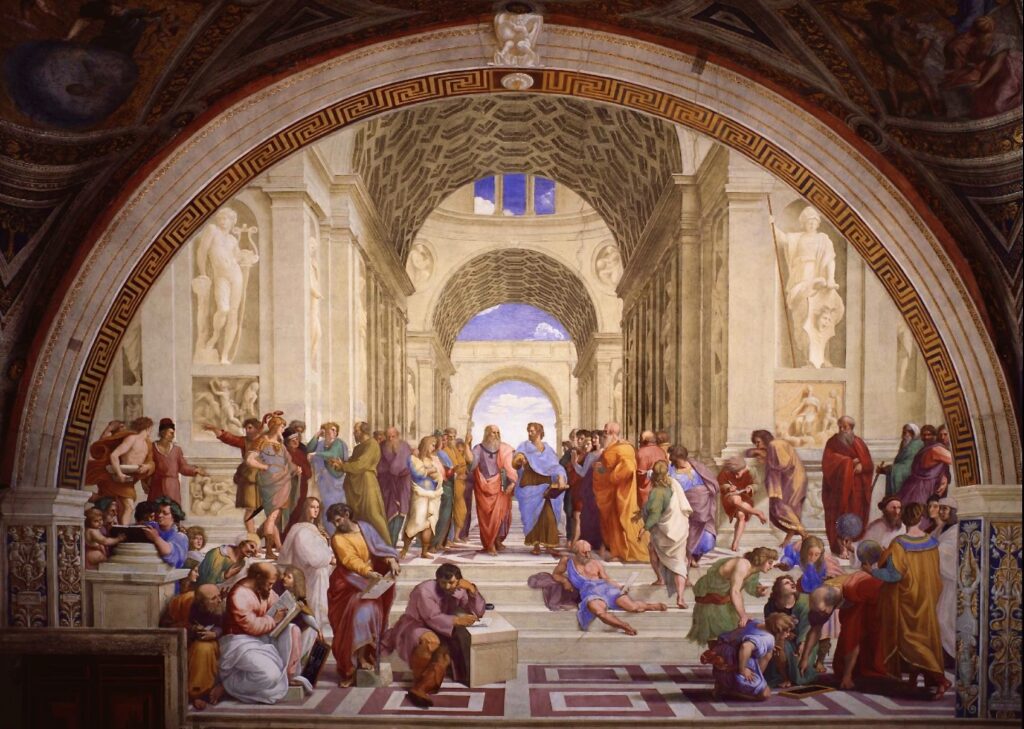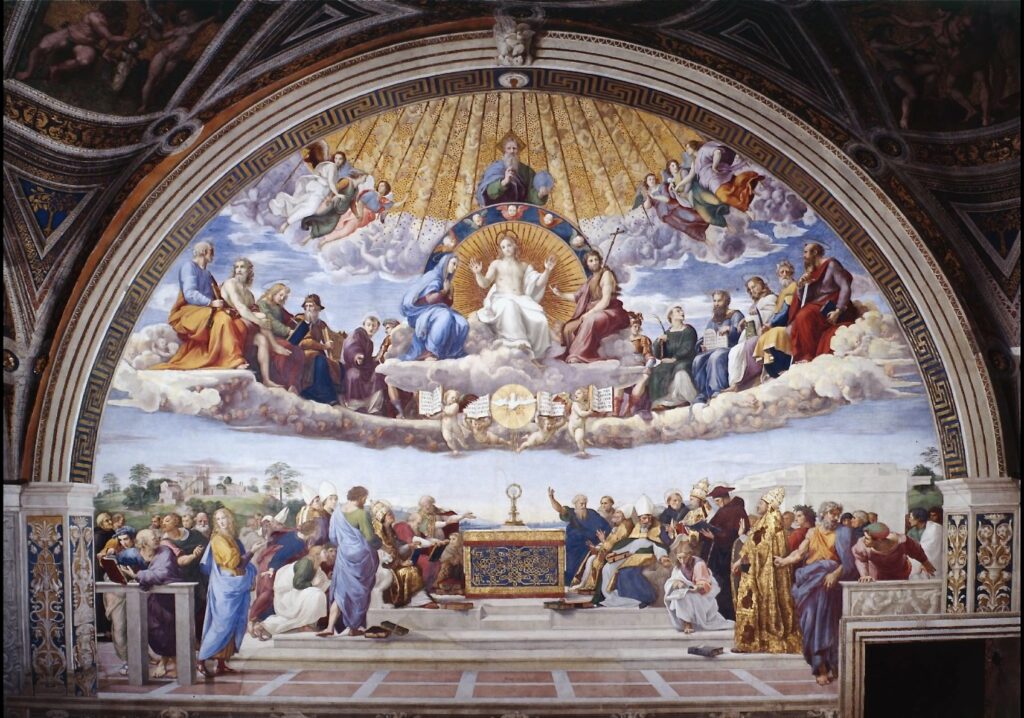The bishops of the United States have summoned Catholics to participate in a Eucharistic Revival. This initiative is due, in part, to reports of a significant decline in Catholics who believe in the Real Presence of Jesus in the Eucharist.
Welcome and necessary as this undertaking is, I think it important to consider more closely two crucially related issues. First, what characterizes the cultural context in which our Eucharistic faith must be lived? Second, who is He whose Real Presence we profess and celebrate in the Sacrament He instituted on this day?
We can obtain some purchase on both these questions by considering two masterpieces of the early 1500s by the great Renaissance painter, Raphael. They have much to teach us. The paintings are the “School of Athens” and the “Disputation over the Sacrament” (the Disputà) which Raphael painted to decorate the Stanza della Segnatura in the Apostolic Palace.
The two paintings, facing one another on opposite walls, are intimately linked, not only spatially but conceptually and imaginatively. Entering the magnificent room, once the library of Julius II, one sees on the far wall the Disputà. But before proceeding, one should turn round to view the “School of Athens,” because it is the prelude to realizing the true breadth of Raphael’s vision.
The famous depictions of Plato and Aristotle in conversation stand at the center. But they are surrounded by famous figures of antiquity, like Euclid and Ptolemy, but also of the present – indicating the continued import of the explorations of the ancients.
Hence, we spy Raphael himself, and, slyly perhaps, a pensive Michelangelo who, at the time, was engaged in painting the nearby Sistine Chapel. Tellingly, Plato holds his Timaeus and Aristotle his Nichomachean Ethics. For the Renaissance artist and thinker, the volumes evoked a multi-dimensional cosmos where virtuous friendship is the acme of human flourishing.

Thus, the viewer turns away, the bearer of two vivid impressions.
First, committed conversation betokens a commonality among the figures, a school of common purpose: the pursuit of truth. Scarcely a “buffered self” (one of the banes of contemporary society) among them.
Second, the setting is a church under construction (the unfinished Saint Peter’s), open to the heavens. For, though not yet professing Christian faith, there is, among the thinkers, an opening to transcendence, to the true and the good. No hint here of secularity’s constricted “immanent frame” that Charles Taylor decries in A Secular Age.
The pilgrim advances, then, towards the Disputà, newly aware of being in company with Plato and Aristotle and others, in quest of the Mystery to be revealed. And that Mystery strikingly finds its form and focus in the Eucharist.
In the magnificent panorama of the Disputà, the earthly horizontal, the pilgrim Church, is paralleled by a loftier dimension, the heavenly Church, in patria. And both are crossed by a vertical line that transcends yet vivifies: the Trinity of God, Father, Son, and Holy Spirit. Vertical and horizontal lines come to rest on the enthroned Host, the “still point of the turning world.”
How might our contemplation of Raphael’s masterworks rekindle our own Eucharistic imagination? Perhaps by confirming our faith conviction that the ultimate reality to which both great frescoes bear witness is “communion”: communion of persons in intimate and mutually nourishing relations. The “School of Athens” aspires to that fulness of personal communion that the Disputà discloses and anchors in the personal presence of the Eucharistic Savior.

In our arid time, when too often isolation and estrangement seem to dominate, the Eucharistic Jesus offers the living water for which we thirst, the bread for which we hunger. He does so not only out of the plenitude of his power, but out of the passionate self-emptying of his love: “With desire I have desired to eat this Passover supper with you.” (Lk 22:15) The Eucharist which Jesus offers us is far from being but one of the many benefits he bestows. It is he himself, total gift. His very being is to be Eucharist: to be bread broken and lifeblood shed.
Eucharist embodies that passion for communion which is Jesus’s mission. “How I have longed to gather you to myself!” (Mt 23:37) Yet, despite repudiation and rejection, “when I am lifted up from the earth, I will draw all people to myself.” (Jn 12:32) For “unless the grain of wheat falls into the ground and dies, it remains alone; but, if it dies, it brings forth much fruit.” (Jn 12:24)
Rich as the fresco is, can we discern a “surplus of meaning” intimated in Raphael’s sublime “Disputà?” For what is “disputation” but to seek a further soul-stretching understanding of the inexhaustible Mystery?
The line of descent from the Father through the Son to the Holy Spirit who hovers over the host may signify more than the “efficient cause” of the Sacrament. It may signal that Jesus’s passion for communion, whose perfect embodiment is the Eucharist, finds its origin and goal in the very life of the Trinity.
Are we, perhaps, pressed to confess the Eucharistic life of the Trinity itself: that giving and receiving in truth, love, and thanksgiving which unites the divine Persons in infinite communion?
How imperative, then, is Eucharistic revival, Eucharistic pondering and contemplation?
In his great Apostolic Exhortation, “Sacramentum Caritatis,” Pope Benedict sounds the challenge:
“The Sacrament of the Altar is always at the heart of the Church’s life: thanks to the Eucharist, the Church is reborn ever anew. The livelier the Eucharistic faith of the people of God, the deeper is its sharing in ecclesial life, in steadfast commitment to the mission entrusted by Christ to his disciples. The Church’s very history bears witness to this. Every great reform has in some way been linked to the rediscovery of belief in the Lord’s Eucharistic Presence among his people,” (Sacramentum Caritatis, no. 6)
Raphael’s inspired imagination helps us glimpse something of the height and breadth, the length and depth of our Eucharistic faith and calling.
You may also enjoy:
Pope St. John Paul II’s Holy Thursday
Fr. Gerald E. Murray’s Priestly Renewal and Holy Thursday














